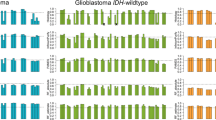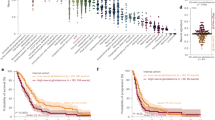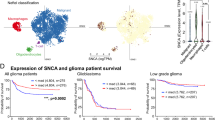Abstract
Loss of heterozygosity (LOH) involving the distal chromosome 1 p36 region occurs frequently in nonastrocytic brain tumours, but the tumour suppressor gene targeted by this deletion is unknown. p73 is a novel gene that has high sequence homology and similar gene structure to the p53 gene; it has been mapped to 1 p36, and may thus represent a candidate for this tumour suppressor gene. To determine whether p73 is involved in nonastrocytic brain tumour development, we analysed 65 tumour samples including 26 oligodendrogliomas, 4 ependymomas, 5 medulloblastomas, 10 meningiomas, 2 meningeal haemangiopericytomas, 2 neurofibrosarcomas, 3 primary lymphomas, 8 schwannomas and 5 metastatic tumours to the brain, for p73 alterations. Characterization of allelic loss at 1 p36–p35 showed LOH in about 50% of cases, primarily involving oligodendroglial tumours (22 of 26 cases analysed; 85%) and meningiomas (4 of 10; 40%). PCR-SSCP and direct DNA sequencing of exons 2 to 14 of p73 revealed a missense mutation in one primary lymphoma: a G-to-A transition, with Glu291Lys change. 8 additional cases displayed no tumour-specific alterations, as 3 distinct polymorphic changes were identified: a double polymorphic change of exon 5 was found in one ependymoma and both samples derived from an oligodendroglioma, as follows: a G-to-A transition with no change in Pro 146, and a C-to-T variation with no change in Asn 204: a delG at exon 3/+12 position was identified in 4 samples corresponding to 2 oligodendrogliomas, 1 ependymoma and 1 meningioma, and a C-to-T change at exon 2/+10 position was present in a metastatic tumour. Although both LOH at 1 p36 and p73 sequence changes were evidenced in 4 cases, it is difficult to establish a causal role of the p73 variations and nonastrocytic brain tumours development. © 2001 Cancer Research Campaign www.bjcancer.com
Similar content being viewed by others
Article PDF
Change history
16 November 2011
This paper was modified 12 months after initial publication to switch to Creative Commons licence terms, as noted at publication
References
Bello MJ, Leone PE, Nebreda P, de Campos JM, Kusak ME, Vaquero J, Sarasa JL, Garcia-Miguel P, Queizan A, Hernandez-Moneo JL, Pestaña A and Rey JA (1995a) Allelic status of chromosome 1 in neoplasms of the nervous system. Cancer Genet Cytogenet 83: 160–164
Bello MJ, Leone PE, Vaquero J, de Campos JM, Kusak ME, Sarasa JL, Pestaña A and Rey JA (1995b) Allelic loss at 1p and 19q frequently occurs in association and may represent early oncogeneic events in oligodendroglial tumors. Int J Cancer 64: 207–210
Bello MJ, de Campos JM, Vaquero J, Kusak ME, Sarasa JL and Rey JA (2000a) High-resolution analysis of chromosome arm 1p alterations in meningioma. Cancer Genet Cytogenet 120: 30–36
Bello MJ, de Campos JM, Vaquero J, Ruiz-Barnes P, Kusak ME, Sarasa JL and Rey JA (2000b) hRAD54gene and 1p high-resolution deletion-mapping analyses in oligodendrogliomas. Cancer Genet Cytogenet 116: 142–147
Bender B, Wiestler OD and von Deimling A (1994) A device for processing large acrylamide gels. Biotechniques 16: 204–206
Corn PG, Kuerbitz SJ, van Noesel MM, Esteller M, Compitello N, Baylin SB and Herman JG (1999) Transcriptional silencing of thep73gene in acute lymphoblastic leukemia and Burkitt’s lymphoma is associated with 5′ CpG island methylation. Cancer Res 59: 3352–3356
De Laurenzi V, Catani MV, Terrinoni A, Corazzari M, Melino G, Costanzo A, Levrero M and Knight RA (1999) Additional complexity in p73: induction by mitogens in limphoid cells and identification of two new splicing variants ɛ and ζ. Cell Death Differentiation 6: 389–390
Fillippovich I, Sorokina N, Gatei M, Haupt Y, Hobson K, Moallem E, Spring K, Mould M, McGuckin MA, Lavin MF and Khanna KK (2001) Transactivation-deficient p73alpha (p73Deltaexon2) inhibits apoptosis and competes with p53. Oncogene 20: 514–522
Han S, Semba S, Abe T, Makino N, Furukawa T, Fukushige S, Takahashi H, Sakurada A, Sato M, Shilba K, Matsuno S, Nimura Y, Nakagawara A and Hossi A (1999) Infrequent somatic mutations of the p73 gene in various human cancers. Eur J Surg Oncol 25: 194–198
Herranz M, Urioste M, Santos J, Martinez-Delgado JB, Rivas C, Benitez J and Fernandez-Piqueras J (2000) Allelic losses and genetic instabilities ofPTENand p73 in non-Hodgkin lymphomas. Leukemia 14: 1325–1327
Hollstein M, Sidransky D, Vogelstein B and Harris CC (1991) p53mutations in human cancers. Science 253: 49–53
Husemann K, Wolter M, Buschges R, Bostrom J, Sabel M and Reifemberger G (1999) Identification of two distinct deleted regions on the short arm of chromosome 1 and rare mutation of theCDKN2Cgene from 1p32 in oligodendroglial tumors. J Neuropathol Exp Neurol 58: 1041–1050
Ichimiya S, Nimura Y, Kageyama H, Takeda N, Sunahara M, Shishikura T, Nakamura Y, Sakiyama S, Seki N, Ohira M, Kaneko Y, McKeon F, Caput D and Nakagawara A (1999) p73 at chromosome 1p36 is lost in advanced stage neuroblastoma but its mutation is infrequent. Oncogene 18: 1061–1066
Jost CA, Marin M and Kaelin WG (1997) p73 is a human p53-related protein that can induce apoptosis. Nature 389: 191–194
Kaghad M, Bonnet H, Yang A, Creancier L, Biscan J-L, Valent A, Minty A, Chalon P, Lelias J-M, Dumont X, Ferrara P, McKeon F and Caput D (1997) Monoallelically expressed gene related top53at 1p36, a region frequently deleted in neuroblastoma and other human cancers. Cell 90: 809–819
Kawano S, Miller CW, Gombart AF, Bartram CR, Matsuo Y, Asou H, Sakashita A, Said J and Tatsumi E Koeffler (1999) Loss of p73 gene expression in leukemias/lymphomas due to hypermethylation. Blood 94: 1113–1120
Kleihues P, Burger PC and Scheitauer BW (1993) Histological typing of tumors of the nervous system. WHO International Histological Classification of tumors, Springer Verlag: Berlin
Kraus JA, Koopman J, Kaskel P, Maintz D, Brandner S, Schramm J, Louis DN, Wiestler OD and von Deimling A (1995) Shared allelic losses on chromosome 1p and 19q suggest a common origin of oligodendrogliom and oligoastrocytoma. J Neuropathol Exp Neurol 56: 1098–1104
Leone PE, Bello MJ, de Campos JM, Vaquero J, Sarasa JL, Pestaña A and Rey JA (1999) NF2gene mutations and allelic status of 1p, 14q and 22q in sporadic meningioma. Oncogene 18: 2231–2239
Levrero M, De Laurenzi V, Costanzo A, Gong J, Melino G and Wang JYJ (1999) Structure, function and regulation of p63 and p73. Cell Death Differentiation 6: 1146–1153
Levrero M, De Laurenzi V, Costanzo A, Sabatini S, Gong J, Wang JYJ and Melino G (2000) The p53/p63/p73 family of transcription factors: overlapping and distinct functions. J Cell Science 113: 1661–1670
Lissy NA, Davis PK, Irwin M, Kaelin WG and Dowdy SF (2000) A common E2F-1 and p73 pathway mediates cell death induced by TCR activation. Nature 407: 642–645
Liu W, Mai M, Yozomizo A, Qian C, Tindall DJ, Smith DI and Thibodeau SN (2000) Differential expression and allelotyping of the p73 gene in neuroblastoma. Int J Oncol 16: 181–185
Mai M, Huang H, Reed C, Qian C, Smith JS, Alderete B, Jenkins R, Smith DI and Liu W (1998) Genomic organization and mutation analysis of p73 in oligodendrogliomas with chromosome 1p-arm deletions. Genomics 51: 359–363
Mashiyama S, Murakami Y, Yoshimoto T, Sekiya T and Hayashi K (1991) Detection of p53 gene mutations in human tumors by single-strand conformation polymorphism analysis of polymerase chain reaction products. Oncogene 6: 1313–1318
Mendiola M, Bello MJ, Alonso J, Leone PE, Vaquero J, Sarasa JL, Kusak ME, de Campos JM, Pestaña A and Rey JA (1999) Search for mutations of the hRAD54 gene in sporadic meningioma with deletion at 1p32. Mol Carcinogenesis 24: 300–304
Mitelman F, Mertens F and Johansen B (1997) A breakpoint map of recurrent chromosomal rearrangements in human neoplasia. Nature Genetics 15: 417–474
Nomoto S, Haruki N, Kondo M, Konishi H, Takahashi T, Takahashi T and Takahashi T (1998) Search for mutations and examination of allelic expression imbalance of the p73 gene at 1p36.33 in human lung cancers. Cancer Res 58: 1380–1383
Ohgaki H, Eibl RB, Wiestler OD, Yasargil MG, Newcomb EW and Kleihues P (1991) p53 mutations in nonastrocytic brain tumors. Cancer Res 51: 6202–6205
Peng C-Y, Tsai C-L, Yeh C-T, Hung S-P, Chen M-F, Chen T-C, Chu C-M and Liaw Y-F (2000) Genetic alterations of p73 are infrequent but may occur in early stage hepatocellular carcinoma. Anticancer Res 20: 1487–1492
Reifemberger J, Reifemberger G, Liu L, James CD, Wechsler W and Collins VP (1994) Molecular genetic analysis of oligodendroglial tumors shows preferential allelic deletions on 19q and 1p. Am J Pathol 145: 1175–1190
Rey JA, Bello MJ, Jimenez-Lara A, Vaquero J, Kusak ME, de Campos JM, Sarasa JL and Pestaña A (1992) Loss of heterozygosity for dsital markers on 22q in human gliomas. Int J Cancer 51: 703–706
Simon M, von Deimling A, Larson JJ, Wellenreuther R, Kaskel P, Waha A, Warnick RE, Tew JM and Menon AG (1995) Allelic losses on chromosome 14, 10, and 1 in atypical and malignant meningiomas: a genetic model of meningioma progression. Cancer Res 55: 4696–4701
Smith JS, Alderete B, Minn Y, Borell TJ, Perry A, Mohapatra G, Hosek SM, Kimmel D, O’Fallon J, Yates A, Feuerstein BG, Burger PC, Scheithauer BW and Jenkins RB (1999) Localization of common deletion regions on 1p and 19q in human gliomas and their association with histological subtype. Oncogene 18: 4144–4152
Takahashi T, Ichimiya S, Nimura Y, Watanabe M, Furusato M, Wakui S, Yatani R, Aizawa S and Nakagawara A (1998) Mutation, allelotyping, and transcription analyses of the p73 gene in prostatic carcinoma. Cancer Res 58: 2076–2077
Tsujimoto T, Mochizuchi S, Iwadate Y, Namba H, Nagai M, Kawamoto T, Sunahara M, Yamahura A, Nakagawara A, Sakiyama S and Tagawa M (2000) The p73 gene is not mutated in oligodendrogliomas which frequently have a deleted region at chromosome 1p36.3. Anticancer Res 20: 2495–2498
Van Gele M, Kaghad M, Leonard JH, Van Roy N, Naeyaert JM, Geerts ML, Van Belle S, Cocquyt V, Bridge J, Sciot R, De Wolf- Peeters C, De Paepe A Caput D and Speleman F (2000) Mutation analysis of p73 andTP53in Merkel cell carcinoma. Br J Cancer 82: 823–826
Versteeg R, Caron H, Cheng NC, van der Drift P, Slater R, Westerveld A, Voute PA, Delatre O, Laureys G, Van Roy N and Speleman F (1995) 1p36: Every subband a suppressor?. Eur J Cancer 31A: 538–541
von Deimling A, Louis DN and Wiestler OD (1995) Molecular pathways in the formation of gliomas. Glia 15: 328–338
White E and Prives C (1999) DNA damage enables p73. Nature 399: 734–735
Yang A, Kaghad M, Wang Y, Gillet E, Fleming MD, Dotsch V, Andrews NC, Caput D and McKeon F (1998) p63, a p53 homolog at 3q27–29, encodes multiple products with transactivating, death-inducing, and dominant-negative activities. Moll Cell 2: 305–316
Yang A, Walker N, Bronson R, Kaghad M, Oosterwegel M, Bonnin J, Vagner C, Bonnet H, Dikkes P, Sharpe A, McKeon F and Caput D (2000) p73-deficient mice have neurological, pheromonal and inflammatory defects but lack spontaneous tumours. Nature 404: 99–103
Yokozaki H, Shitara Y, Fujimoto JY, Hiyama T, Yasui W and Tahara E (1999) Alterations of p73 preferentially occur in gastric adeno carcinomas with faveolar epithelial phenotype. Int J Cancer 83: 192–196
Yoshikawa H, Nagashima M, Khan MA, McMenamin MG, Hagiwara K and Harris CC (1999) Mutational analysis of p73 andp53in human cancer cell lines. Oncogene 18: 3415–3421
Author information
Authors and Affiliations
Rights and permissions
From twelve months after its original publication, this work is licensed under the Creative Commons Attribution-NonCommercial-Share Alike 3.0 Unported License. To view a copy of this license, visit http://creativecommons.org/licenses/by-nc-sa/3.0/
About this article
Cite this article
Alonso, M., Bello, M., Gonzalez-Gomez, P. et al. Mutation analysis of the p73 gene in nonastrocytic brain tumours. Br J Cancer 85, 204–208 (2001). https://doi.org/10.1054/bjoc.2001.1855
Received:
Revised:
Accepted:
Published:
Issue date:
DOI: https://doi.org/10.1054/bjoc.2001.1855
Keywords
This article is cited by
-
Homozygous deletion of TNFRSF4, TP73, PPAP2B and DPYD at 1p and PDCD5 at 19q identified by multiplex ligation-dependent probe amplification (MLPA) analysis in pediatric anaplastic glioma with questionable oligodendroglial component
Molecular Cytogenetics (2014)
-
Overexpressed TP73 induces apoptosis in medulloblastoma
BMC Cancer (2007)
-
The role of p73 in hematological malignancies
Leukemia (2006)
-
p73 modulates HIV-1 Tat transcriptional and apoptotic activities in human astrocytes
Apoptosis (2005)
-
Identification of two contiguous minimally deleted regions on chromosome 1p36.31–p36.32 in oligodendroglial tumours
British Journal of Cancer (2004)



